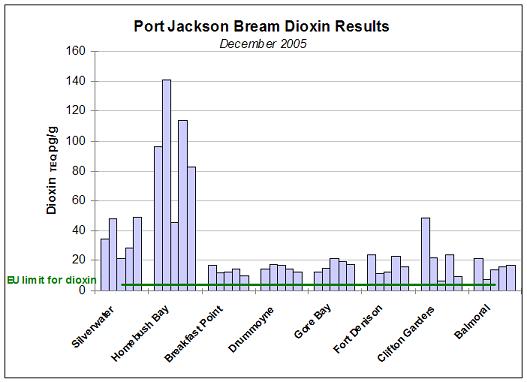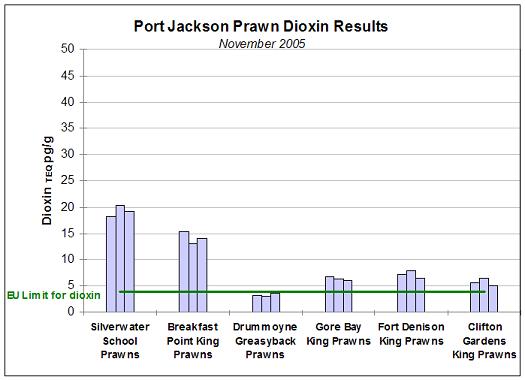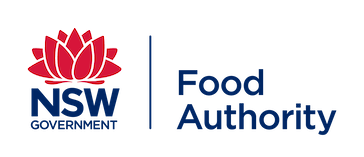Dioxins and Port Jackson
Concerns arose in 2005 about levels of dioxin in seafood in the Sydney Harbour/Parramatta River area. Testing of seafood species resulted in consumer dietary advice to limit consumption.
Test results for Sydney Harbour / Parramatta River seafood
2007 test results
Tests by NSW Department of Primary Industries have established dioxin levels in 2 additional species: Dusky flathead and Fan-belly Leatherjackets. These have been added to the consumer dietary advice.
2006 test results
In 2006, the NSW Department of Primary Industries tested a range of common recreational species. These results were used by an Expert Panel to recommend the consumer dietary advice.
2005 testing of bream and prawns
Results for both Bream and Prawns are summarised in the charts below. Please note Homebush Bay has been closed to fishing since 1989.
A number of samples were taken from each location.
There are many types of dioxins. The information below is calculated using 29 of the most toxic dioxins present and weighting each based on its toxicity.


What do the results tell me?
The results show all edible samples of seafood from Port Jackson are above the current European Union limit for dioxins in food.
Greasyback prawns are low, but these are usually only taken for use as bait.
The European Union limit for dioxins in food is 4TEQpicogram of dioxins per gram of seafood (marked by a green line in the charts above). This is a measure of the amount of dioxin in fish or prawn tissues. One picogram per gram is equivalent to one part per trillion.
There is no consistent international standard on dioxin levels. For example, as mentioned above, the European Union has a limit of 4TEQpicogram of dioxins per gram of seafood , while the USA previously had a limit of 50 part per trillion although withdrew it in favour of dietary advice. Australia has no maximum standard. The Government has closed the Harbour as a precautionary measure.
The Expert Panel’s dietary information presented above was calculated from these results. This was done by averaging the result for bream and prawns across the waterway (Port Jackson) and then determining an amount of seafood from the waterway people can safely consume each month. It should be noted that occasionally exceeding this advice per month would not be likely to result in a significant health risk.
